

Height vs. Width
Birds fly side to side, not up and down. When I first started out breeding budgies I had a cage that was about 18" wide
and long and about 4' high. It might as well have been 24" high because thatís the extent of it that my budgies used.
Birds need space, but not height. Width is much more important. Had the cage been 18" wide and tall and 4' long my budgies
would have used the entire thing. Stick to rectangular cages that are longer/wider than they are tall.
Bird Size
How big are your birds? A macaw will need a much larger cage than a budgie. Many of the resources Iíve read tell you that
the cage should be large enough for the bird to extend its wings without touching the bars, and large enough to turn around
in without smacking the side. This is too small. For a hospital cage this would be fine because you are trying to
restrict movement; however a day-to-day cage that the bird lives in should be double or triple this size. It should be able to
hold two perches spaced greatly apart as well as toys.
Another funny thing about most parrots is that the smaller they are, the more space they need proportionally. Budgies
require a huge amount of space when compared to a macaw (not quite to scale, but see below). This is due to their
activity level. I cringe every time I see budgies kept in those tiny, blue, house-shaped cages that aren't even one foot in ANY
dimension. This is like a human being forced to live in their shower stall or closet!
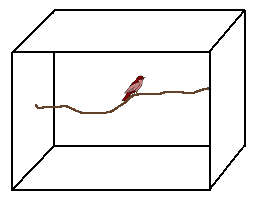
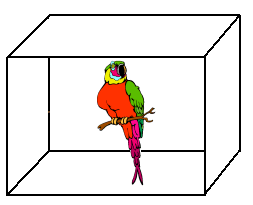
Activity Level
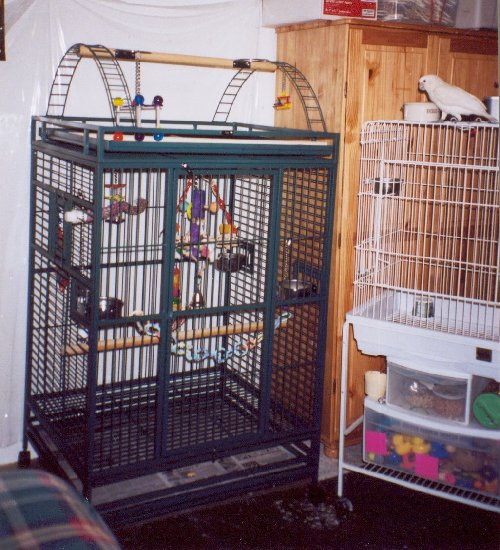 One budgie requires 2-3 times as much space as a cockatiel. Why? Because budgies are more active! This is why smaller birds
need more space- generally they are much more active than the larger birds. You can see the difference just by picking them up:
budgies and most parakeets "jump" onto your finger (or your shoulder, or your head...); parrots usually "step up," rather than hop to you. Know your species: kakarikis, lovebirds and budgies are all extremely active. Nonpsittacine species like finches, toucans, mousebirds and other "softbills" are all very active. These birds require a huge amount of space no matter what their size- toucans require an aviary, macaws don't.
One budgie requires 2-3 times as much space as a cockatiel. Why? Because budgies are more active! This is why smaller birds
need more space- generally they are much more active than the larger birds. You can see the difference just by picking them up:
budgies and most parakeets "jump" onto your finger (or your shoulder, or your head...); parrots usually "step up," rather than hop to you. Know your species: kakarikis, lovebirds and budgies are all extremely active. Nonpsittacine species like finches, toucans, mousebirds and other "softbills" are all very active. These birds require a huge amount of space no matter what their size- toucans require an aviary, macaws don't.
This is not to say that all larger parrots are inactive and don't require much space. It is important to keep in mind the activity level of the individual bird as well. When my mitred conure Fry died, I bought a goffin cockatoo, Loki. Fry's cage was brand new, and huge step up from the original cage he came in. Fry was a fairly inactive bird, so it suited him just fine. Loki, who is relatively the same size as Fry was, found this cage abysmally small. Loki is an extremely active bird, and also easily bored, which means that many toys are required to keep his interest. Fry's cage was barely large enough for three of Loki's toys, let alone Loki himself. I began searching for a new cage, and ended up getting macaw/large cockatoo cage. The new cage currently contains 12 toys (two more on the playstand above), and there is still room for him to hop about.
How much time will the bird spend in the cage?
If you work away from home and your bird is locked up all day, then the cage needs to be very large. Like Loki's cage, it should have plenty of room for toys, and also plenty of room for the bird to hop about. Fry's cage [barely] had room for either one or the other. It's easy to overestimate the size of an unfurnished cage. If you're at a store, try placing a few toys inside to get a better feel for how much room you actually have to work with. If the bird won't be able to move around much with three toys hanging inside, then the cage is too small. For a bird that is home all day, the cage should be able to fit at least 2-3 perches (one can be a swing), 4-6 toys, food dishes and the bird itself (with room to jump from perch to perch).
Playstands
If the bird is out of its cage for a good portion of the day, then the cage can be smaller. A birdie-safe "play area" will give your bird a change of scenery and allow it to interact more with you. If a bird is out all day (for those lucky people who work at home) the cage can be much smaller because your bird will only be using it at night. Playstands should make up for the lack of cage size and contain plenty of toys, perches and other goodies to keep your bird occupied.
Mutiple Birds and Mixing Species
More birds means more space. Bickering is normal but if certain birds are picked on more than others or if they are fighting over food/water/perches then the cage is probably too small. When mixing species you must take into account what each is like. Nonaggressive species like budgies and tiels can mix but only if the tiels have room to get away from the budgies, whose constant activity will drive them nuts. See my article on Colony Breeding for more tips.
Shapes
No round cages! No cute house-shaped cages! Cages should be designed for birds, not humans. If you like the shape so much YOU go live in it. Odd angles trap toes, create unused space and make cleaning and accessing the cage a nightmare. Stick to squares and rectangles.
Most small species are fine with 1/2 spacing. Larger birds can have wider spacing, just not so wide that they can get their heads caught. Larger birds will also require thicker wire to keep them from chewing through. There should be plenty of horizontal bars. Clipped birds especially require these to help them get around the cage.
Finish
Many cages are galvanized. This is fine, but the process of galvanizing can leave traces of zinc and other metals on the wire which can kill your bird. Rinse all galvanized cages with a mixture of vinegar-water to remove these trace metals.
Bottom Grate
This feature keeps your birds from picking at dropped food and feces, as well as the substrate (you can use colored newspaper again!). I highly recommend getting a cage with this.
Acrylic Cages
These cages have their own distinct pros and cons. They are designed for optimal visibility and reduced mess. However, they contain no horizontal bars (although some now add a wire "climbing wall"), have reduced ventilation and climate control, and are extremely expensive.
Below are examples of actual cages offered for sale. My negative comments are in red, my good comments are in blue. |
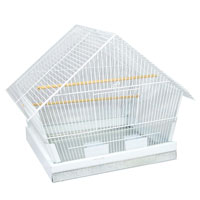 |
Coast Cages Sunburst Cage for Parakeets, Canaries & Finches
|
 |
Petco Deluxe Kit for Canary & Finch "This deluxe starter kit begins with a stylish, quality cage..."
|
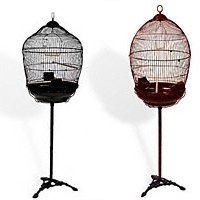 |
Avian Select Parakeet Cages
|
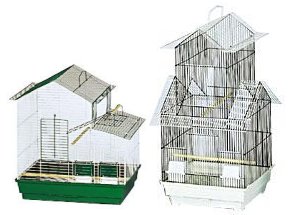 |
Prevue Split Level Cockatiel Cage & Prevue "Beijing" Jumbo Bird Cage
|
 |
California Cageworks All-Purpose Cages
|
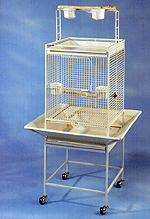 |
CP100 "The Belize" Play Top by California Cages
|
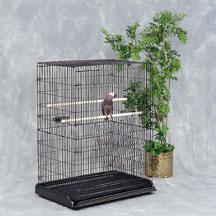 |
MidWest Small/Medium Parrot Cage
|
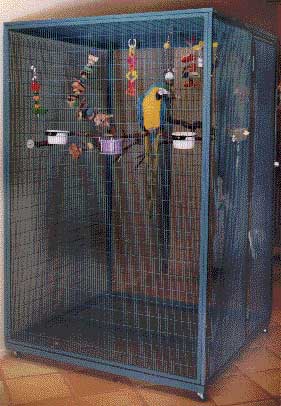 |
Exotic Enclosures
|
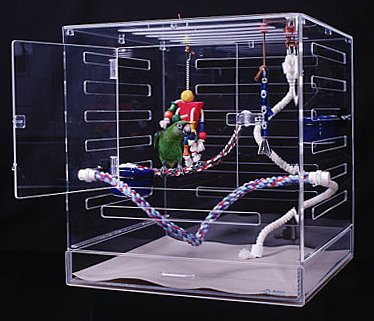 |
Parrot Island Acrylic Medium Cage
|
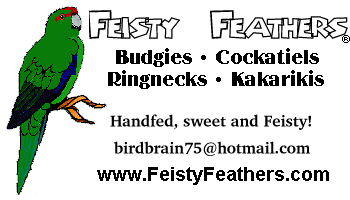
Product images stolen from various websites selling them. Everything else is © 2001 by Karen Trinkaus unless otherwise noted and may not be reprinted or used in any way without the author's permission.